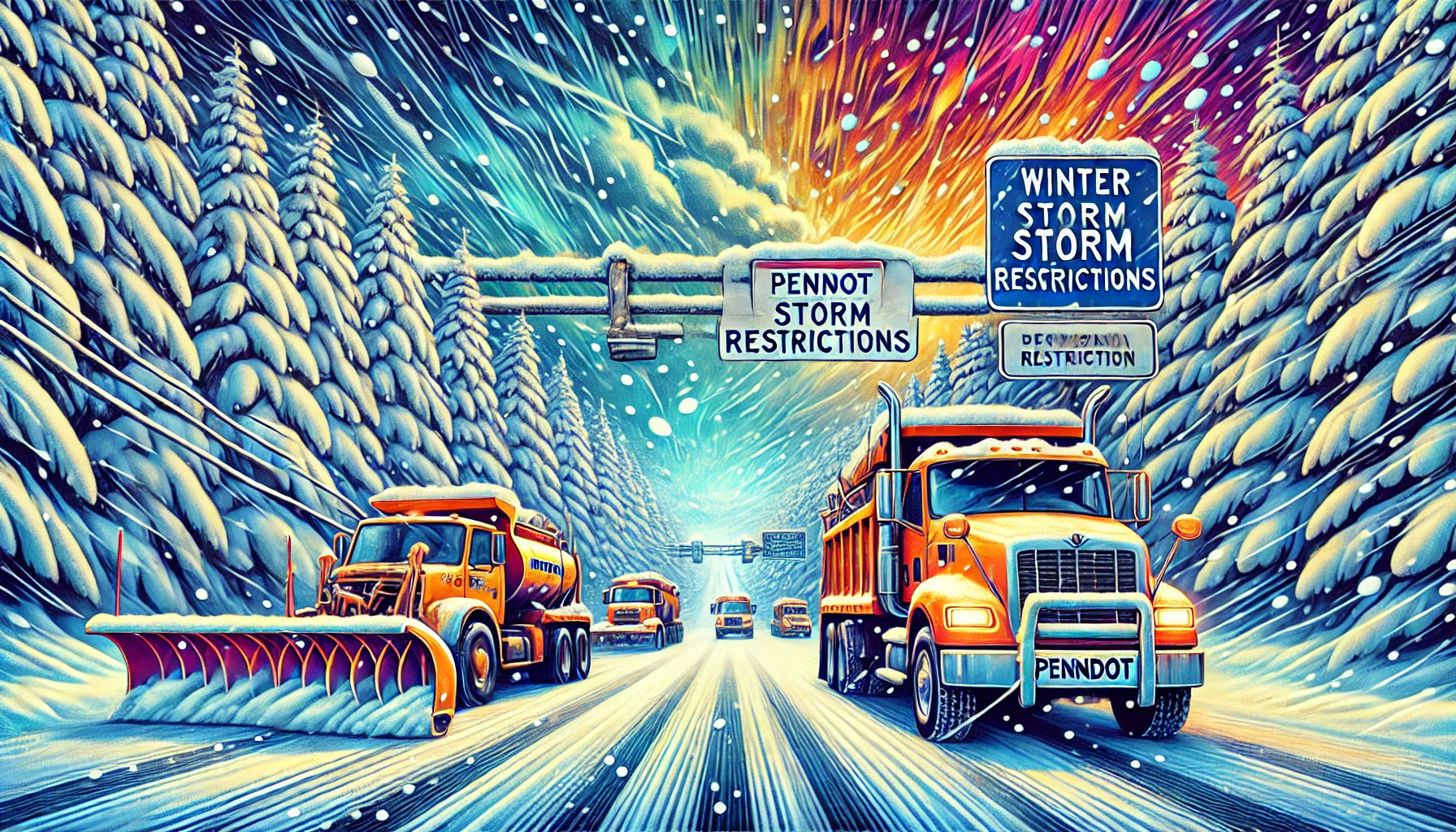Introduction
Winter storms can bring treacherous driving conditions that significantly impact road safety. In Pennsylvania, these challenges are addressed by the Pennsylvania Department of Transportation (PennDOT) through winter storm restrictions that limit certain vehicles from travelling on roadways during severe weather events. One of the most commonly implemented restrictions is the PennDOT winter storm restrictions under the Tier 2 vehicle rules, which prohibit specific vehicle types from travelling on designated highways during winter storms. Understanding PennDOT winter storm restrictions and how these rules affect vehicle access to roads is crucial for any travelling in Pennsylvania during the winter months.
In this article, we’ll dive deep into what PennDOT winter storm restrictions entail, why these restrictions are necessary, and how you can stay informed during winter storms to ensure your safety and avoid penalties. Let’s explore how PennDOT winter storm restrictions help keep the roads safer for everyone during harsh weather conditions.
What Are PennDOT Winter Storm Restrictions?

PennDOT winter storm restrictions are a set of measures enforced by the Pennsylvania Department of Transportation to maintain safe driving conditions during winter storms. These restrictions are designed to control traffic flow on highways, particularly when snow, freezing rain, or icy conditions make travel dangerous. The restrictions also facilitate the worksnowploughslows and emergency vehicles by reducing the number of vehicles on the roads and preventing accidents.
PennDOT classifies these restrictions into different levels, depending on the severity of the storm. Each level of restriction applies to different types of vehicles and routes, and PennDOT winter storm restrictions often include Tier 2 rules for specific vehicle bans. These restrictions are vital to ensuring the smooth operation of winter storm response and preventing traffic jams or accidents caused by vehicles that are ill-equipped to handle snowy or icy conditions.
Tier 2 Restrictions: What Are They?
When PennDOT winter storm restrictions are enforced, Tier 2 restrictions are often applied. This means that certain vehicles—especially large ones or those prone to sliding—are restricted from using specific roads. Tier 2 restrictions are typically enacted when the weather conditions are severe enough to affect the safety of these vehicles. The main goal is to prevent accidents and allow emergency and snow removal vehicles to work without interference.
What Does Tier 2 Restriction Mean?
Tier 2 restrictions primarily target non-passenger vehicles, especially large trucks and trailers. These restrictions are imposed when snow and ice make it difficult for heavy vehicles to maintain traction, slowing down snow removal operations and increasing the likelihood of accidents. The goal of PennDOT winter storm restrictions at this level is to minimize traffic disruptions, reduce accidents, and ensure that emergency vehicles can quickly access the affected areas.
Vehicles Affected by PennDOT Winter Storm Restrictions

The following vehicles are typically restricted under Tier 2 restrictions during winter storms:
1. Tractors Without Trailers
Tractors without trailers are often banned from roads under PennDOT winter storm restrictions. While a tractor may seem harmless, its lack of stability due to the absence of a trailer makes it harder to control on icy or snowy roads. These vehicles can easily lose traction or slide during winter storms, posing a risk to themselves and other drivers.
2. Unloaded Trucks
Unloaded or lightly loaded trucks are less stable in winter conditions, as their lack of cargo means there is less weight to provide traction. As a result, these vehicles are prohibited from travelling on specific highways or roads under PennDOT winter storm restrictions. Even without a full load, these trucks can become prone to accidents and difficulty in stopping when road conditions deteriorate.
3. Recreational Vehicles (RVs)
RVs are particularly susceptible to the effects of snow and ice. Due to their large size, high profile, and rear-heavy weight distribution, RVs can become unstable on slippery roads. Even experienced drivers may find it difficult to maintain control of these vehicles in hazardous conditions. For this reason, PennDOT winter storm restrictions apply to RVs and motorhomes during winter storms.
4. Buses
Public transportation buses, school buses, and private buses are also affected by PennDOT winter storm restrictions. These vehicles have a large surface area and can be challenging to control in poor weather conditions. During snowstorms or icy conditions, buses are more likely to experience difficulty braking or turning safely. Consequently, buses are typically restricted during winter storms to minimize risks to passengers and other road users.
5. Motorcycles
Motorcycles are banned frotravellinggng during PennDOT winter storm restrictions due to their lack of stability on slick or snowy surfaces. Since motorcycles are two-wheeled vehicles with relatively low weight, they are highly prone to skidding and losing control in poor weather conditions. PennDOT winter storm restrictions often place a blanket ban on motorcycles during winter storms to avoid accidents and fatalities.
6. Passenger Vehicles Towing Trailers
Cars, trucks, or SUVs towing trailers are also restricted under Tier 2 rules. The added weight and length of the trailer make it harder for the driver to maintain control on snowy or icy roads. The additional load can cause the trailer to sway, making it more difficult to stop or change lanes safely, particularly on steep or winding roads. For safety reasons, vehicles towing trailers are prohibited from travel when PennDOT winter storm restrictions are in effect.
Why Are PennDOT Winter Storm Restrictions Necessary?

The imposition of PennDOT winter storm restrictions, particularly Tier 2 restrictions, during a winter storm is based on the need to protect both drivers and emergency personnel. During snowstorms or freezing rain, road conditions can become hazardous very quickly. Vehicles like large trucks, buses, and RVs struggle to maintain traction, while smaller vehicles may have a greater chance of manoeuvring safely on snow-covered roads.
PennDOT winter storm restrictions help reduce the number of large or unwieldy vehicles on the road, preventing accidents that could clog up highways and make it harder for snowploughs, emergency vehicles, and road maintenance crews to work effectively. By keeping roads clear of vehicles that are ill-suited for winter driving, PennDOT winter storm restrictions ensure safer conditions for everyone.
How to Stay Informed About PennDOT Winter Storm Restrictions
One of the best ways to stay up to date with PennDOT winter storm restrictions is by using the 511PA service. The 511PA website and mobile app provide real-time updates on road conditions, closures, and travel restrictions across the state.
Using 511PA for Real-Time Updates
The 511PA service provides a range of valuable features:
- Live Traffic Updates: Get up-to-the-minute information on road conditions and closures due to winter storms, accidents, or roadwork.
- Winter Storm Alerts: Stay informed of any PennDOT winter storm restrictions or other travel limitations during a winter storm, including which vehicles are restricted from travelling.
- Traffic Cameras: View live traffic cameras for conditions on major highways, so you can see for yourself how bad the weather is before heading out.
- Detours and Route Changes: In case of road closures, 511PA will provide alternate routes to help you reach your destination safely.
By checking the 511PA website or downloading the mobile app, you can easily monitor PennDOT winter storm restrictions in real-time. It’s especially important to check 511PA before starting your trip, as weather conditions can change quickly.
Preparing for Winter Storm Travel in Pennsylvania
While following PennDOT winter storm restrictions is important, it’s also essential to prepare your vehicle and yourself for winter driving. Here are some steps to ensure you’re ready for winter weather:
1. Prepare Your Vehicle
Before travelling during winter conditions, ensure your vehicle is in top shape. Key preparations include:
- Tyres: Check the tread on your tyres and consider switching to winter tyres if you expect harsh weather.
- Battery: Cold temperatures can drain your vehicle’s battery, so ensure it’s in good condition and fully charged.
- Windshield Wipers: Replace worn-out wiper blades and top off your windshield washer fluid with an antifreeze solution.
2. Pack Emergency Supplies
Keep an emergency kit in your car, especially during winter storms. Some essentials include:
- Blankets and extra clothing
- Non-perishable snacks and water
- A flashlight and extra batteries
- A first-aid kit
- A fully charged phone and a portable charger
3. Monitor Weather Reports
Always check the weather forecast and road conditions before heading out. In addition to 511PA, you can also listen to local news and weather broadcasts for any winter weather alerts or warnings.
4. Adjust Your Driving
When driving during winter conditions, always adjust your speed and driving habits. Reduce your speed to match the road conditions, increase the distance between you and other vehicles, and avoid sudden movements that can cause your vehicle to lose traction.
Conclusion
PennDOT winter storm restrictions, particularly Tier 2 vehicle rules, are crucial for ensuring the safety of all drivers during winter storms in Pennsylvania. By understanding these restrictions and knowing which vehicles are affected, you can better prepare for and navigate winter weather conditions. The 511PA service provides valuable, real-time information that helps you stay informed about road conditions, closures, and restrictions, allowing you to make the safest decisions when travelling during winter storms.
Remember to prepare your vehicle, carry emergency supplies, and stay updated on weather alerts. By following these precautions, you can safely navigate Pennsylvania’s highways during winter storms and help keep roads clear for emergency vehicles and snowploughs working to restore normal traffic flow.




